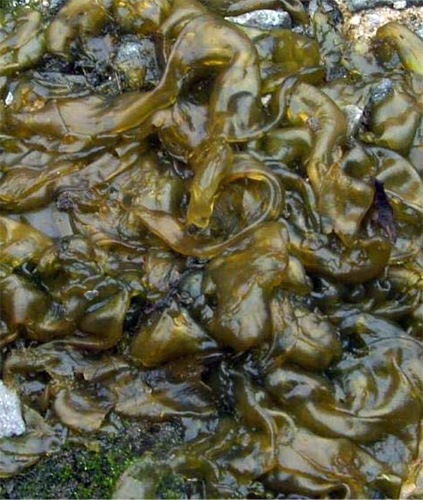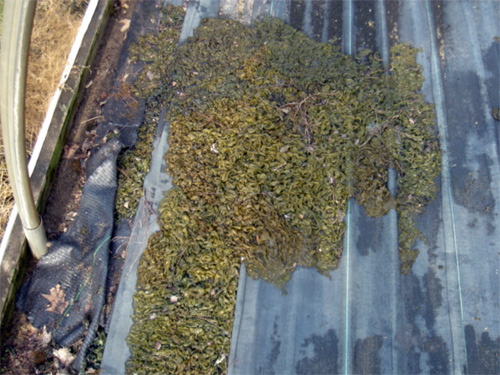Nursery growers should watch for blue-green algae in container growing areas
Blue-green algae are showing up more often in container growing areas in nurseries and are difficult to control. Chemical and cultural controls are limited in effectiveness due to the nature of the algae’s ability to survive extreme conditions.
Nursery container growers over the past few years have been finding a new problem in their nursery. It is a slimy-when-wet, blue-green Nostoc spp. of algae (Photo 1). These are not your typical aquatic forms of algae that inhabit irrigation ponds or streams, but are ones that survive in terrestrial sites. In fact, they are not even classified now as algae but are called cyanobacteria because they can conduct photosynthesis like higher plants. They are considered to be among the most ancient organisms to inhabit the earth with some fossil records showing they have been on earth for over 3.5 billion years.

Photo 1. Close up of cyanobacteria. Photo credit: Desmond Down, Down Garden Services
The problem with these primitive cyanobacteria is their slimy nature. When wet, they cause a slip-trip hazard to workers moving plants in a container growing area (Photo 2). I have seen the organism growing on hard-packed alley ways, container ground mats, aggregate stone walkways and even concrete sidewalks in retail sales areas. The organism has the capability of manufacturing and discharging polysaccharides from their cells. These discharges form a coating that protects the cyanobacteria from stresses like drought, high and low temperatures or other conditions that allow them to survive in a nursery setting quite well.

Photo 2. Cyanobacteria growing in a polyhouse. Photo credit: Thomas A. Dudek, MSUE.
Cyanobacteria will develop more rapidly in size if phosphorus fertilizer is present in their growing environment albeit from the soil, container media, and water sources. So in managing this problem, one needs to reduce the phosphorus movement off target, or in other words, reduce the phosphorus lost from the plants you are growing to reduce cyanobacteria development.
It appears that watering practices are important as well since this problem occurs more often in the summer when water usage by plants is at its peak, so grouping plants by water requirements is critical in a container growing area. Recent research by Tom Fernandez, Department of Horticulture at Michigan State University, has shown we actually get better plant growth when using less water than previously thought for many ornamental plants. Contact Fernandez at fernan15@msu.edu for more details on this research.
Improving surface drainage is another critical issue in preventing the development of this pest. I have observed that well-drained sites are less prone to its development. Consider better tiling and even sub-soiling to break up compacted soils. Surface tillage may actually spread the problem across the nursery site because the algae, when broken up, will reproduce from the small fragments in areas where it is carried to.
Chemical controls that have been reported in the literature include the following.
- Fungicides like mancozeb and chlorothalonil when applied on a 7- to 14-day schedule on golf course putting greens have shown to create some relief, but need to be reapplied if conditions become favorable.
- Copper sulfate at 1.3 oz./gallon of water per 1,000 sq. feet has also been reported to be effective if reapplied every 7 to 14 days.
- I have also seen some benefit when applying sodium carbonate peroxyhydrate granules to this organism. The cyanobacteria must be wet prior to application.
If you have small amounts of this organism in your nursery, shovel it up and remove it from your site by sending it to a landfill. Avoid breaking it up and spreading it in compost or dragging it around your farm.



 Print
Print Email
Email




